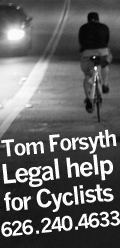The year was 1940, a new concept for an ambitious transportation corridor from LA to Pasadena
was in the works. The traditional routes, Griffin Avenue, Pasadena Avenue, Figueroa Street, just weren't
cutting it for those car-crazy Angelenos who wanted a faster way. The Arroyo Seco Parkway (not a freeway
in the modern sense) was routed straight north from DTLA to Pasadena. But this would chop up all of the
above streets to the point where they could not be used to directly access Pas from LA.
What with the War to End All Wars heating up in Europe and the far east, with gasoline about to be
rationed, and with an economy just recovering from the Great Depression, this would be a great blow
to not-yet-car-dependent LA residents. In those days, people would actually shed their exoskeletons
(cars) and venture forth on foot for insanely long distances, miles even.
So these walkers had to be provided for and the new Arroyo Seco Parkway would contain a foot path.
I wasn't around LA then (I was a little kid in NYC), but I suppose if you had an "A" stamp* on the
windshield of your Model A Ford, you could not spare the gasoline for that excursion and
would be more than willing to trudge that walkway north with nothing but your Tom McAns to wear out.
As late as the 1970s and 80s, I used to see this walkway in regular (albeit occasional) use.
Nowadays, it is very trashy, horribly noisy from the I-5 interchange traffic, very narrow in places
due to intruding retrofitted structural columns, and less than convenient for most pedestrians.
But it does make a great bikeway! You will have to carry your bike up and down the staircases and
possibly over the areas with a deep layer of broken glass. It does provide a car-free route from
Chinatown to NELA, the alternative would be North Broadway/Pasadena Ave/Figueroa St. which has
high car traffic with freeway crossings.
*During WWII gasoline was rationed. Cars were issued windshield stickers with letters on them
designating the amount of gas allowed. The "A" sticker was the lowest priority, with an allowance
of four gallons per week. The bigger problem was tires, there was an extreme shortage of rubber. Speed
limits for the duration of the war were 35 mph, which was fine for the Arroy Seco Parkway which, while
having limited access, has many curved sections with lower speed limits than modern freeways.
 Harv
Harv01.1.13 - 8:12 am
reply
Mr. R: You are correct. It was. But it didn't, so we had another war.
To continue the saga of the footpath/bikeway along the Arroyo, you can pick it up at about Ave 43 and take it to York, after which there is only a very rough rocky path northward. Some years ago, the late Dennis Crowley would lead bike rides alongside the Arroyo north of York to trace the path of the Horace Dobbins bikeway which failed to materialize but lead the way to the 110. We would find scattered traces of the original foot path along the Arroyo Seco, paved with asphalt and too narrow for anything but peds, bikes, and maybe horses and buggies.
And there's even more... A few years ago I attended several meetings at the LA River Center regarding the extension of the York to 43 Arroyo Bikeway to meet up with the LA River bikeway. The money was available and a design was done. However, the engineers at CalTrans knew nothing about what was needed for a successful bikeway and we criticized their plan by doing a field trip to the site, walking the route, and showing them what was wrong with their design.
It was back to the drawing board to implement our suggestions, more meetings, then the money disappeared and the whole project put on hold.
I can't remember everyone at the meetings, but there was Joe Linton, the CICLE girls, Michele Mowery, Jeff Chapman, Josef Bray-Ali, and probably some that are now reading this thread.
 Harv
Harv01.1.13 - 3:59 pm
reply
 -->
-->



